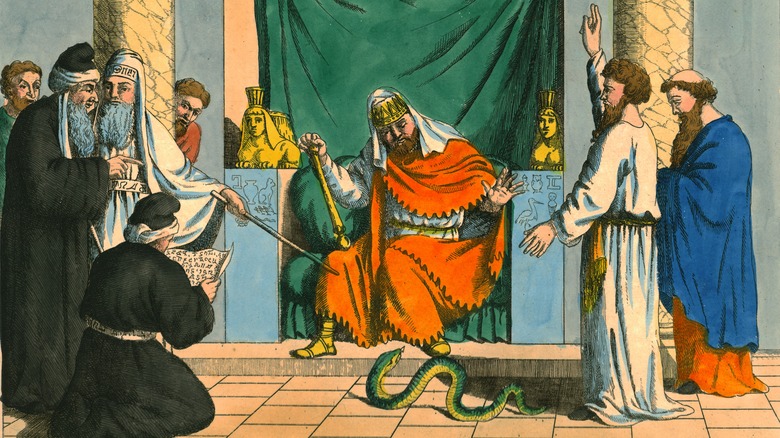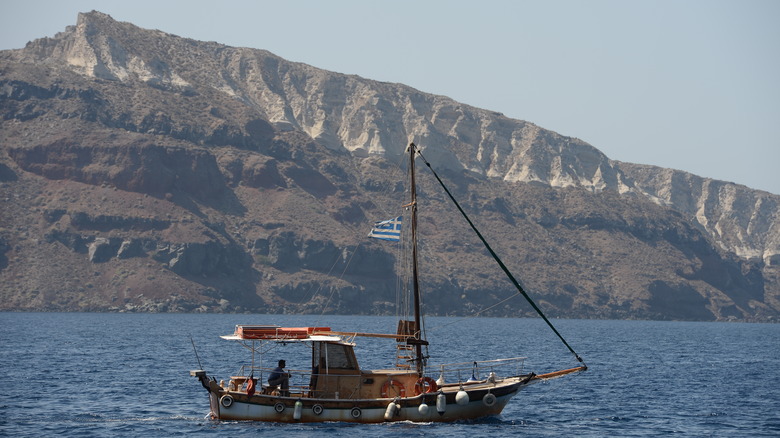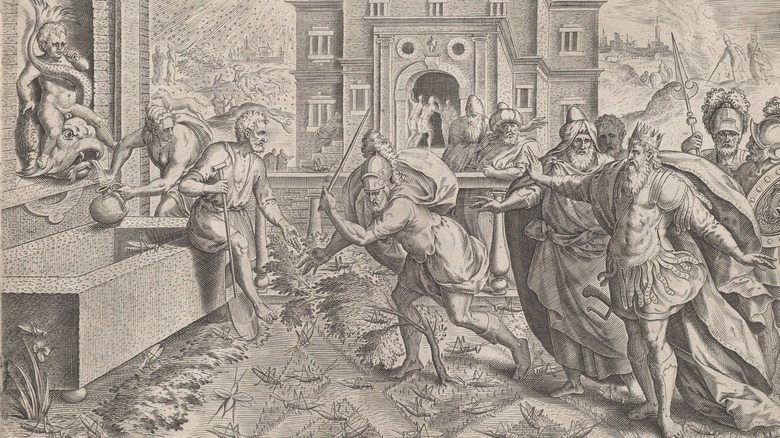The Theories About The 10 Plagues Of Egypt That Would Change Everything
The 10 Plagues of Egypt are among the many Biblical events that people tend to take at face value. These plagues are detailed early in the Book of Exodus, where the prophet Moses and his brother Aaron confront an unnamed pharaoh of Egypt and ask him to free the Israelites from slavery or face the consequences. The pharaoh refuses each of these requests, and as he keeps hardening his heart (as Exodus so helpfully points out), Moses and Aaron work closely with God to conjure up a series of plagues, each one more devastating than the last. Starting from the waters of the Nile turning into blood, the rest of the 10 Plagues, in order of occurrence, include frogs; small insects (possibly lice); flies, wild animals, or a mixture of both; pestilence; boils; a fiery hailstorm; locusts; three days of darkness; and the death of firstborn.
Sounds fantastical, doesn't it? Up to this day, many still believe that the plagues are an example of what could happen to a person in power who repeatedly refuses to acknowledge the man upstairs. They insist that each of them literally took place thousands of years ago, serving as the divine intervention that finally granted the Israelites their freedom. However, there are some scientific theories that suggest the 10 Plagues of Egypt really happened — but just not in the way the Bible says they did.
Volcanic eruptions on Santorini might have led to the plagues
Thousands of years before it became a popular tourist destination, the island of Santorini, located southeast of the Greek mainland, was the site of the Minoan eruption, a catastrophic event that is considered one of the largest volcanic eruptions of the last 10,000 years, according to Volcano Discovery. Taking place around 1613 BCE, it is also believed to be one of the natural events that could explain the bizarre goings-on during the 10 Plagues of Egypt. As cited by Time, microbiologist Siro Trevisanato wrote in his book, "The Plagues of Egypt: Archaeology, History and Science Look at the Bible," that the volcanic ash from Santorini may have extended all the way to Egypt and contained a mineral known as cinnabar. This mineral could turn water red, which lines up with the first of the 10 Plagues — the Nile River turning into blood.
If you come to think of it, that's yet another example of why much of the Bible shouldn't be interpreted literally. It may boggle the mind as to how God could punish the Egyptians by turning their water into blood, but Trevisanato's theory suggests there's a scientific explanation behind it all. But that's far from the only plague he was able to link to the Minoan eruption — in fact, he somehow associated all of the plagues with something related to what happened on Santorini.
Volcanic ash and acid rain could have caused the other plagues
According to Time, the second plague might have happened as a result of the cinnabar making the water acidic, thus causing frogs to frantically leap from one point to another while searching for clean water, while the third and fourth ones — the lice and the flies (assuming they weren't larger creatures) — could have started after insects burrowed in the bodies of living humans and dead animals as Egypt continued to feel the effects of the eruption on Santorini.
Plagues No. 5-8 appear to be closely linked to each other based on what Trevisanato posited, and might have been caused by acid rain — another byproduct of the volcanic ash from Santorini. The rain would have poisoned the grass, resulting in "pestilence" once consumed by farm animals, and would have also landed on people, causing them to develop boils on their skin. Along with the acid rain came hailstorms, which is in line with how the Bible describes the seventh plague, except for how it's highly likely they weren't as fiery as they were cracked up to be. Due to the humid conditions brought about by the rain and hailstorms, locusts had ideal conditions to thrive in. And just as you can expect from any major volcanic eruption, the ash could have very easily caused the three days of darkness in the ninth plague.
Last, but not least is the death of every firstborn son in Egypt. According to Trevisanato, the fallout from the Santorini eruption might have made the country's residents desperate enough to sacrifice their firstborn in an effort to appease the gods and end their suffering. He reportedly came to this conclusion after finding archaeological evidence of ancient text that mentioned "children of aristocrats lying dead in public," as Time described it.
Red tide and possible domino effects
In 1996, epidemiologist Dr. John Marr presented a "novel" theory that was published by the New York Times, in which he suggested that the presence of red algae in Egyptian waters might have brought on a domino effect similar to what Trevisanato detailed, but different in terms of its origin. According to a paper co-written by Marr, the red tide could have killed the fish, depriving frogs of a primary source of food and forcing them to search elsewhere. The frogs then starved to death, leading to swarms of insects (including lice and flies) roaming free and feeding on the corpses of dead animals. Meanwhile, the lice could have also been an insect called culicoides, which lays its eggs in the dust (hence the dust turning into lice, per the Bible?) and sickens livestock through diseases that include African horse sickness and Bluetongue, thus getting the fifth plague of pestilence out of the way.
Moving on to the boils, Marr wrote that they may have been related to glanders, a disease that was only described by Aristotle in 330 BCE but existed well before that; no prizes if you guessed that it's caused by eating tainted meat or by contact with flies. The hailstorm, he suggested, might have happened independently, but might have also caused a second domino effect, one where the crops that were affected by the hailstorm were fed on by locusts, with the mold on the remaining crops creating airborne toxins that killed many children and animals — or firstborn creatures, as stated in the Book of Exodus. As for the three days of darkness? Marr believes this was caused by a sandstorm that would have also damaged the crops.
Here's why some people still believe God made the plagues happen
The Bible says that it was the 10th and last plague that finally convinced the pharaoh to free his slaves, and with the Israelites liberated, the seven-day holiday of Passover was created and has been celebrated ever since (via Britannica). The holiday is one of the most important in the Jewish calendar, and it involves a lot of symbolism and traditions, including the consumption of unleavened bread, or matzo, during the seven-day period; this represents the Israelites' ordeal while they were enslaved, as well as the haste of their actual exodus from Egypt following their liberation.
However, there are those who believe the biblical narrative of the 10 Plagues of Egypt holds more significance than any scientific explanation. "To me it doesn't matter whether scientists are able to find a historical basis for something that happened around 3,500 years ago," Interfaith Center for Sustainable Development executive director Rabbi Yonathan Neril told Time. "The central message is that God brought the plagues on Egypt in order to free the Israelite slaves."
Nonetheless, Neril acknowledged that science could help people understand why the plagues supposedly happened. He also offered an interesting analogy that compared the pharaoh's obstinate refusal to free the Israelites to how modern society insists on the use of fossil fuels despite their link to climate change. "Fossil fuels, in the past 150 years, have replaced slave labor as the key driver of human society," he said. "There's a Pharaoh within us that wants to continue to do something that's not right."




